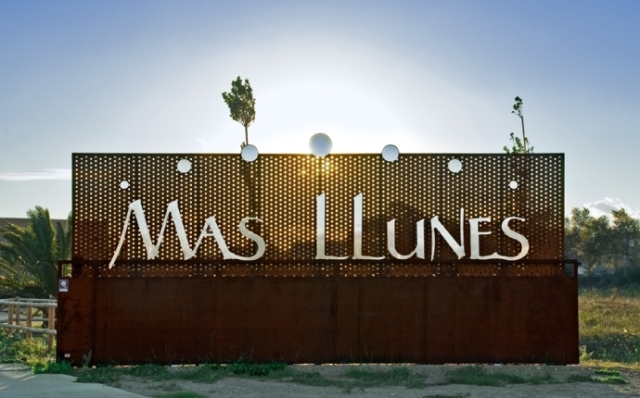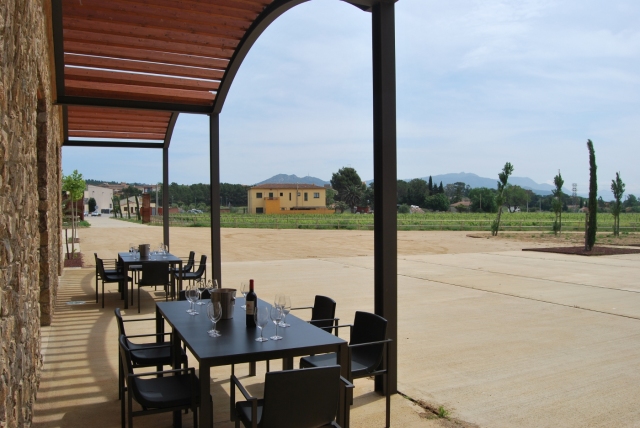125/365 – Catalonia – Falset – Castell del Vi – Wine Fair – Cooperative Falset Marçà – Etim Grenache Old Vines 2008
Água de Beber……,
…., Water to Drink at the Wine Castle? I think not! I have to remind myself over and over again, that during the difficult years, when Priorat and other regions saw their decline, co-operative wine cellars still fought on and produced wine. Maybe not the best in the world but certainly good enough for the money you would pay. Today, most co-operatives work with high technology and with some great wine makers. To some extent, the difficulty they are having, is with the bulk wines, the mechanical harvest (which makes quality selection so much harder) and timings. Due to the large amounts coming to the wineries at the same time, it is virtually impossible to give the grapes the best reception.

Nevertheless, it is certainly possible to find great wines made by the co-operative cellars, which was proven during the small fair at the Castell del Vi in Falset the other day! Several new wines were tasted and I have firmly decided to visit some of the producers that took part. The Wine Castle is run by a foundation, which praised the conclusion of the second edition of the Fair of agricultural cooperatives of the Priorat region. It was a great showcase for the diversity and quality of the wines and oils produced by cooperative wineries of the region, some with over 100 years of history. During the day, more than 300 entrance tickets were sold, which means there were approximately 600 people participating.

The tables are set and the fair was just about to start!
This year, the Fair was attended by 9 agricultural cooperatives from the region and one guest cooperative from D.O. Terra Alta, the Cooperrative Cellar of Gandesa, considered one of the Cathedrals of Wine in Catalonia. During the day, the cooperative wineries presented their new wines in the l’Absis hall of the Castle. Wine tastings of different categories were offered, both targeted and blind. Their other products, like olive oil and cured meats and cheeses were also on display.

This centre is based in the former Castle of the Counts of Prades of Falset, built in the 12th century after the Christian re-conquest of New Catalonia and located on a strategic hill overlooking the town of Falset. The castle which was made up of a residential quarter and a church, the existence of which can only be seen in the former exterior walls, was partly destroyed on several occasions, such as the decree of Philip the Fifth. In recent years, before it was completely abandoned, it was also used as a prison.

The Castell del Vi takes up three floors of this former fortress. Modern infrastructure and advanced technology has meant that the centre offers visitors a very different experience based on Priorat wine culture, which is far removed from that of a traditional wine museum. By using audiovisual and interactive elements, visitors easily understand the history and the peculiarities of this wine-growing region.

On the gorund floor visitors are introduced to the world of wine, the region of the Priorat through the use of emblematic images and suggestive decorative elements. They also receive a brief introduction to winemaking from the vineyard to the winery by use of short videos. The first floor concentrates on the region’s history and what makes the area unique. It is divided into two contrasting spaces: A grape growing Region, Visitors are greeted by a large 3D relief model of the Priorat where a short film, projected onto the model, takes us back in time. The exhibition space is complimented with fixed panels and glass cases which emphasize the idiosyncrasy and curiosities of this region.

I got to try an excellent Rose wine by Celler de Cornudella de Montsant, which was paired quite well with semi cured cheese!
Protagonist, Homage to the people who have contributed to the re-birth of the region. This interesting set up allows visitors to get to know some of the most important faces in this renaissance. Furthermore, a series of interviews informs visitors of personal experiences and points of views of the diverse people who were involved in this process. The second floor is called The Lookout. This open plan floor space provides visitors with splendid views over the region and invites them to go out to explore its countryside, its hidden corners and its festivals. Modules with touch screens as well as normal ones mean that nothing is missed.

At the other end of this room, a series of touch screens offer visitors information about wine production in the region as well as in the rest of the world. Finally, special glass spheres offer visitors the opportunity to appreciate and recognize the basic aromas of Priorat wines in the form of an entertaining exercise to test our senses. If you only have limited time, once you visit Falset, because I assume you will visit Falset one day soon, then you should visit at least the Co-Operative wine cellar and the Castell del Vi!
 Etim Grenache Old Vines 2008
Etim Grenache Old Vines 2008
Vines of more than 50 years of age offering very low outtake, vineyards with slate, clay, limestone and sand, at a height of between 350 and 500 m. Intense pomegranate, well covered with purple trim and rich in color. The nose surprises with an intense aroma of strawberry, currant and blackberries. Blueberries and blackberries dominate and there are subtle balsamic and mineral points. The aromas evolve and points towards the toasted notes of the barrel aging. The palate is elegant, lively and well balanced wine with fruit flavors, good acidity and firm, round tannins. The ending is long, the berries, vanilla and wood are felt throughout.
254 to go!
 The name derives from the name of the vineyards and as the property was acquired, the new owners didn’t want to change the name. The winery itself was built during the turn of the millennium, equipped with a modern winemaking system. The 48 hectares of vineyard produce around 200.000 Kg of grapes, which is all vinified in the cellar.
The name derives from the name of the vineyards and as the property was acquired, the new owners didn’t want to change the name. The winery itself was built during the turn of the millennium, equipped with a modern winemaking system. The 48 hectares of vineyard produce around 200.000 Kg of grapes, which is all vinified in the cellar.
































































